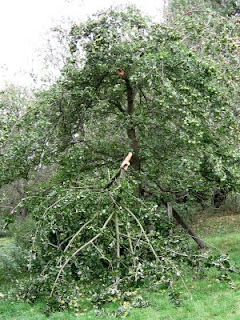 Well, that's it for another year. The elbow-length rubber gloves have been peeled off for the last time, everything thoroughly washed down, and the press now sits dismantled in the corner of the ciderhouse until next years harvest.
Well, that's it for another year. The elbow-length rubber gloves have been peeled off for the last time, everything thoroughly washed down, and the press now sits dismantled in the corner of the ciderhouse until next years harvest.It's been a longer season than usual, starting with the Malvern Hills perry pears we picked way back in September, and finally finishing last Monday with the last batch of Vilberie cider apples. We've ended up with almost 500 gallons of cider and perry, and the only thing which stopped us making more was a lack of space and eventually running out of fermenters! Here's what we've made this year (the variety shown in bold makes up the major part of the blend):
Ciders
- Bulmers Norman/Unknown Bittersweet and Sweets/Bramley (250 litres) - S.G 1.052
- Yarlington Mill/Dabinett/Harry Masters' Jersey/Blenheim Orange (250 litres) - S.G 1.058
- Yarlington Mill/Blenheim Orange (190 litres) - S.G 1.060
- Yarlington Mill/Bramley (130 litres) - S.G 1.058
- Mixed Dessert/Culinary (possible Welland Valley Special) (130 litres) - S.G 1.054
- Vilberie/Unknown Dessert/Bramley (560 litres) - S.G 1.049
- Malvern Hills/Blakeney Red (130 litres) - S.G 1.066
- Blakeney Red 1.050 (250 litres) - S.G 1.050
- Mixed Unknown Perry Pears (130 litres) - S.G 1.046
- Green Horse/Unknown Perry Pears (130 litres) - S.G 1.050
- Single Variety Uknown Perry Pear (60 litres) - S.G 1.060
Sugar levels (the Specific Gravity reading at the end) are up across the board this year, and therefore final alcohol levels will be up significantly too. It's also likely that the general quality of the ciders and perrys will be higher as a result. The higher percentage of bittersweet cider apples in the ciders this year should result in a fuller, richer flavour to our Rockingham Forest Cider, which will be a blend of the three main batches, ie. Bulmers Norman, Yarlington Mill, and Vilberie. Some of the individual pressings may be left unblended if they prove to be of sufficient quality.
I'm particularly pleased with the amount of perry we've made this year, though it could have been much greater given a little more time and a longer 'panking pole'. The perrys will probably remain unblended and sold under their varietal names where known.
So, what have we learnt this year? As usual, quite a lot. The learning curve is as seep as ever, which is as it should be. If we're not learning new things every year, we're obviously not trying hard enough! This year we've learned:
- The difference between 'ripe' and 'mature' fruit, particularly in the case of cider apples and perry pears. Cider apples are generally ripe when they fall, or can be shaken easily from the tree, but that doesn't necessarily mean they are fully mature and ready to press. Some further time may be needed before the fruit has fully developed it's flavour, and pressing too early can lead to a lower quality cider or perry.
- That a good rule of thumb when pressing full bittersweet cider apples is to blend with approximately one third sharp apples to achieve the correct level of acidity. By chance this is what we did with the Vilberie, pressing one sack of sharper apples for every two bittersweets. The ideal acidity level for a balanced cider is considered to be between 5 and 6 parts per thousand Malic Acid, so we were particularly pleased that when we tested our Vilberie blend, it came out at 5.6ppt.
- That we need a bigger ciderhouse, and more hours in the day!










